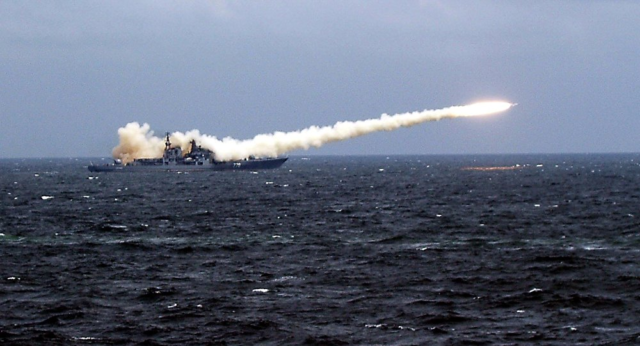
Moscow Prioritizes the Development of Hypersonic Weapons
Publication: Eurasia Daily Monitor Volume: 18 Issue: 36
By:

Since Moscow’s entry into the civil war in Syria in September 2015, its experimentation with high-precision cruise missile strikes has served to boost this element of the Russian defense industry and to convince the political-military leadership to prioritize the further development of such systems (see EDM, June 20, 2020). One critical aspect in this developmental process is Moscow’s interest in producing hypersonic cruise missiles capable of overcoming any air-defense system in the world. To date, the most advanced Russian hypersonic cruise missile version that has reached the testing stage is the 3M22 Tsirkon, with a reported speed of Mach 8 (see EDM, December 11, 2019).
The Tsirkon, designed by Mashinostroyenia, is reaching the conclusion of its state trials and could enter service in 2022; it will have naval surface and sub-surface versions, with ongoing work to create a ground-based variety. This is part of a wider pattern of populating Russia’s Armed Forces with high-precision and hypersonic weapons systems, which will offer a considerable boost to its conventional military capabilities and can be expected to pose a long-term challenge to potential adversaries (Rossiyskaya Gazeta, December 26, 2020). The successful testing of the Tsirkon on October 7, 2020, against a sea-based target in the Barents Sea was publicized as a significant breakthrough. Meanwhile, the anti-ship system would greatly enhance Russian naval capabilities as the Tsirkon can be used on any surface vessel equipped with the launchers for the naval versions of the Kalibr cruise missile (see EDM, October 21, 2020).
According to Deputy Defense Minister Alexei Krivoruchko, plans for military modernization as set out in the 2020 State Defense Order (Gosudarstvennyi Oboronnyi Zakaz—GOZ) were fulfilled at a level of 98.8 percent, despite pressures on the domestic industry stemming from the COVID-19 global pandemic. Krivoruchko referred to planning for the testing and introduction of the Tsirkon hypersonic cruise missile: “Serial deliveries of the Tsirkons will begin in 2022.” He added that this is part of an overall drive to develop and deliver more high-precision weapons for Russia’s conventional Armed Forces. The Ministry of Defense has heavily advertised the testing of the Tsirkon hailing its trial launch from the frigate Admiral Gorshkov as the world’s first hypersonic sea-based cruise missile launch. Such tests have reportedly recorded speeds of more than Mach 8. The defense ministry intends to introduce this hypersonic missile into the Military-Maritime Fleet (Voyenno-Morskoy Flot—VMF) in surface and sub-surface versions (Voyenno Promyshlennyy Kuryer, February 8, 2021).
Sources in Russia’s military defense industry indicate that planned tests for the Tsirkon in 2021 will involve launches from the Severodvinsk multi-purpose nuclear submarine. It will carry out at least two test launches of the hypersonic missile. These will take place from both surface and underwater positions. In 2020, the state-level trials of the Tsirkon involved three launches: two aimed at sea targets and one at a ground target (B-port.com, February 26). Although some evidence suggests that the defense ministry also plans a ground-based version of the Tsirkon system, there have been no reported trials of this variant (News.ru, March 1).
In late December 2020, defense ministry sources indicated that in the first half of 2021, four Tsirkon launches would be carried out by the Northern Fleet’s Admiral Gorshkov; and in the second half of the year, submarine-based tests would be done from the Severodvinsk. If these reports prove to be correct, the missile will be tested seven times this year. In all military media reporting on these tests, each has been described as successful. The number of planned tests for this year seems to suggest further refinements are required before the VMF procures the missile (Rossiyskaya Gazeta, December 26, 2020).
It is worth noting that the Russian Ministry of Defense continues to stress that production targets are being met, despite the impact of the global pandemic. Moscow based defense-journalist Oleg Falichev, writing in Voyenno Promyshlennyy Kuryer, notes, “The Ground and Airborne Forces received 244 units of new and refurbished models of armored weapons and equipment in the fourth quarter of 2020. In particular, [they obtained] 86 new and 158 refurbished units, and also 996 new and 85 repaired vehicles, more than 350 units of rocket and artillery weapons, a divisional set of the Buk-M3 anti-aircraft missile system, [as well as] more than 920,000 units of portable weapons and equipment.” The Aerospace Forces received “a regimental set of the S-400 Triumph anti-aircraft missile system, 15 new and 18 repaired aircraft, 13 new and 10 repaired helicopters, 6 space vehicles, [along with] 50 new and 46 repaired radars…” As for the navy, its units took control of “4 new warships, 1 new and 1 refurbished submarine, 9 new and 11 refurbished ships and support vessels, more than 160 missile and mine-torpedo weapons, and the Bal coastal missile system” (Voyenno Promyshlennyy Kuryer, February 8).
While it is certainly possible that these achievement figures are inflated or manipulated for political purposes, it appears that Russia’s military modernization is continuing at quite a strong momentum. In particular, the effort to develop and procure hypersonic cruise missile systems is also making progress, though perhaps more slowly than the Kremlin had hoped when announcing these plans in February 2019 (see EDM, June 20, 2020). Still, these systems are not only receiving considerable long-term state investment, but they play an important role in the further development of Moscow’s strategic deterrence strategy by creating a robust and potentially unstoppable high-precision conventional “non-nuclear” deterrence level. Equally, as with any of these systems, they pose a theoretical threat for use in differing conflict types as well as for the purposes of coercion. Undoubtedly, despite the lack of Russia’s “blue water” naval capability, the future procurement of the Tsirkon will prove to be a considerable asset.



